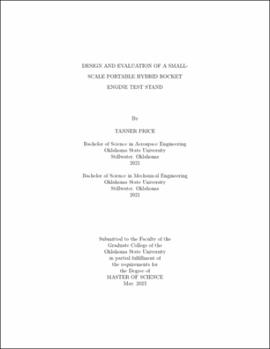| dc.description.abstract | This paper presents the design and evaluation of a small, portable hybrid rockettest stand that can accommodate up to a 3-in diameter engine casing. The primary goal
of this study is to determine the most effective way to build a hybrid rocket test stand for
fundamental research purposes. Various design ideas were considered, including the use of
roller bearings and a vertically oriented test stand. The final design of the stand is oriented
horizontally with the use of 3 flat aluminum plates mounted to linear bearings on T-slot
structural framing. The linear bearings allow the most forward aluminum plate to contact
and press against the load cell while maintaining minimal friction with the T-slot structural
framing. The oxidizer delivery system begins at a 10-lb NOS bottle at 775-psi, going through
an adjustable pressure regulator, through an on/off solenoid valve, and finally through an
orifice plate before being injected into the combustion chamber. The test stand uses a Futek
LLB400 button load cell with a 500-lb capacity, to measure the thrust produced by the
engine. A LabVIEW Virtual Instrument controls the solenoid valve, the ignition process,
and thrust measurement. Thrust and impulse evaluations of the hybrid rocket engine were
conducted on a 1.5-in diameter solid fuel grain over various mass flow rates controlled by the
pressure regulator at 200, 300, and 400-psi, the open area of the orifice plate at 0.24-in, and
nozzle throat diameters at 13/64-in, 16/64-in, 19/64-in and 25/64-in. All solid fuel grains
were composed of 3D printed Polylactic Acid and had a typical Bates grain geometry with
a core size of 0.65-in, length of 3.5-in, and 50% infill. The constructed test stand showed an
optimal range of nozzle sizes between the #16 and #19 nozzles. The stand also demonstrated
the ability to resolve differences in thrust and impulse at a 90% confidence level; showing the
design of the test stand is viable for future research purposes. Future studies should focus
on various fuel grain diameters, NOS injector designs, pre- and post-combustion chambers,
and different fuel grain geometries and compositions. | |
